Some days, it feels like horses are bound and determined to injure themselves in even the safest of settings, such as a turnout.
Protection with turnout boots is a must, whether your horse is a klutz who doesn’t pay attention to their whereabouts or if they’re one that gets themself into sticky situations and gets injured as a result.
Then there are horses who seem to pick up mud fever or scratches when it’s slightly damp outside and need protection to prevent the condition from starting. Flies are another issue that can lead to a horse going nuts or injuring themselves, or even stomp off their shoes.
Turnout boots help you address these issues with various designs, purposes, materials, and more. They can help to keep flies off the legs, protect a sore from getting worse, protect the entire leg, and even help heal lower leg injuries.
The following is a look at different types of turnout boots, how to use them, what to expect from their use, and how the materials help protect your horse while they’re turned out.
P.S. To learn about other types of horse boots, check out this article.
This article contains affiliate links, which means we may earn a commission if you decide to make a purchase.
Why are Turnout Boots Important for Horses?
Turnout boots are designed to protect your horse’s legs from irritants such as wet conditions and insects, as well as provide protection for a healing wound. They’re also used for keeping the lower legs clean and providing protection from the sun.
Using turnout boots provides a convenience for both owner and horse in that they save time, stop worrisome conditions from forming, and protect the horse from itself.
As with most things related to horses, turnout boots have a bit of controversy associated with their use. One study found that the use of any type of closed boot created adverse conditions for the tendons they’re intended to protect. Meanwhile, untold numbers of horse owners say that they rarely experienced an issue with using turnout boots.
Ultimately, turnout boots deliver benefits for the horse by making them more comfortable and keeping out unwanted agents that cause irritation.
The use of turnout boots needs to be approached on a case-by-case basis. Some types, such as a fly wrap or injury boot, have properties that allow for maximum airflow while protecting against lost shoes and the worsening of a wound.
In contrast, the full-leg mud fever wrap does a great job of preventing mud fever scratches as well as providing UV protection, but its design all but guarantees trapped heat and sweat against the leg. It’s best to limit your horse’s turnout time when they’re wearing wraps, or turn them out at night when conditions are less likely to bring UV damage and biting insects.
In general, use your best judgment for using turnout boots. Horses are individuals, with some having highly reactive and sensitive skin while others seem to shrug off anything that comes their way. Use your knowledge of your horse’s proclivities when it comes to applying turnout boots and how long they should be used.
Here’s a look at some of the reasons for when you should, and should not, use turnout boots.
When SHOULD You Use Turnout Boots?
You should use turnout boots when you notice your horse has an injury of some kind and requires protection, if your horse is rough with itself or pasture mates, or you want to keep your horse protected against insects and skin conditions. Another practical reason for using boots is to keep your horse’s legs in good visual condition before a show.
Use turnout boots in accordance with the current weather and temperature conditions. Fly boots are beneficial when the weather is hot and humid as they breathe while keeping flies off the legs. They’re also useful if your horse has a loose shoe and you need it to stay in place until the farrier gets there.
A fly boot also protects against UV damage, and can be used in place of other types of boots to protect against the sun.
Mud fever/scratch boots are intended for use in muddy and wet conditions that can lead to a dermatological condition. However, they’re fully enclosed and require the use of water-resistant or waterproof materials. These materials, while keeping mud and water out, also trap heat. They should be used judiciously and for shorter periods of time.
Horses that are recovering from an injury can wear a supportive boot to help prevent re-injury and encourage faster healing. The concerns about keeping a horse booted during turnout aren’t applicable here, as turnout time is generally short for a horse with a leg injury.
The one boot that can be worn by a horse 24/7 without problems is the bell boot. The bell boot covers the hoof, coronet band, and lower pastern joint only. Heat build-up isn’t a concern in these areas as the bell boot is supposed to have a looser fit. Its design also allows air to flow through, even with the full rubber upside-down cup style.
When Should you NOT Use Turnout Boots?
You shouldn’t use turnout boots on your horse if you intend to keep your horse turned out for long periods of time. Boot manufacturers recommend a maximum wear time of 12 hours in order to prevent problems from forming. Ideally, you should keep the boots on for short periods of time as turnout boots have issues that are inherent to their design and use.
Just about every type of boot traps heat against the leg—something that’s not problematic during riding, but can lead to problems if left on for hours at a time. Heat generation and entrapment creates an environment that can lead to soft tissue damage if not monitored properly. In fact, one study found that it took longer than three hours for the temperature in a horse’s lower leg to return to baseline numbers after wearing wraps for two hours.
The main reason for limiting the use of turnout boots is the fact that temperatures can reach a point that damages tendon cells. In general, don’t use turnout boots during hot weather unless they’re breathable and you’re checking leg temperature after turnout. You’ll know if your horse’s legs are getting too hot by touch, but if you want to dial in the optimal boot wearing time, you can use a no-touch thermometer.
A lesser problem, but a problem all the same, is wet skin caused by the boots getting soaked with water. Turnout boots are made from materials that get wet easily and transfer this moisture to the horse’s leg, potentially leading to a skin condition that’s difficult to resolve. Don’t use boots in wet weather, muddy turnouts, or dewy conditions to prevent a skin condition from forming.
The Best Turnout Boots for Horses
Here are our picks for the best brands for turnout boots in each category:
Professional’s Choice VenTECH All-Purpose Boots (Best Overall)
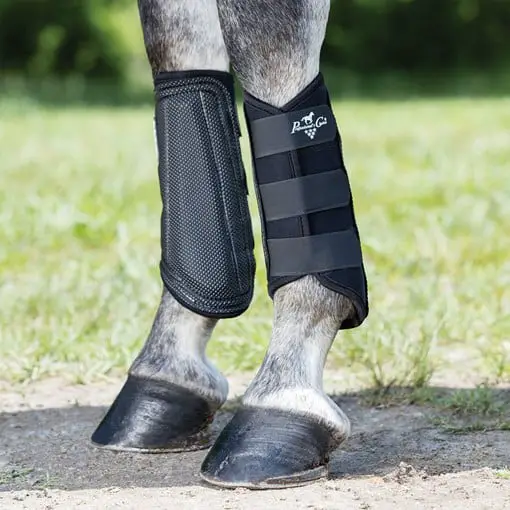
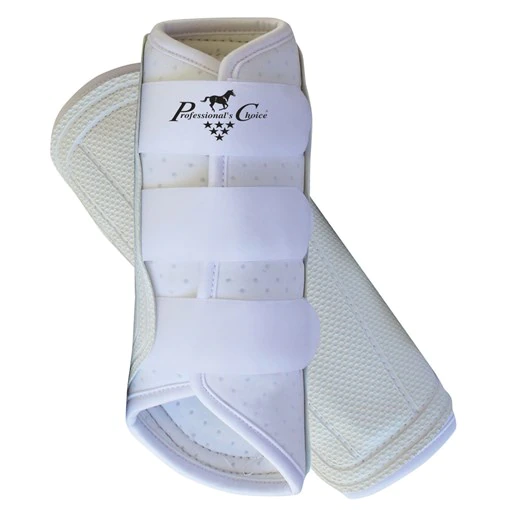
The VenTECH boots from Professional’s Choice are perfect for turnout time and light riding activities. They provide coverage for the lower cannon bone and inside coverage of the fetlock joint and have a PVC padded strike plate on the side to prevent a hoof from connecting with the cannon bone.
The boots are strong enough for use in turnout and as light protection during exercise. Their universal shape means they can be used on the front legs and back, or as a set of four. Make sure to measure your horse’s cannon bones to get the right fit.
Three Velcro straps help keep the boots in place and easy to put into place. While they don’t have a L and R indication on the boots, their shape makes it easy to determine which boot goes on what leg. The boots are made from breathable neoprene, and won’t absorb water in wet conditions. Their breathability means the horse’s leg will stay cool and comfortable. Just use a brush, damp cloth, or hose to clean.
Buy at Stateline Tack | Buy on Amazon
Equilibrium Equi-Chaps Close Contact Chaps (Best Fit)
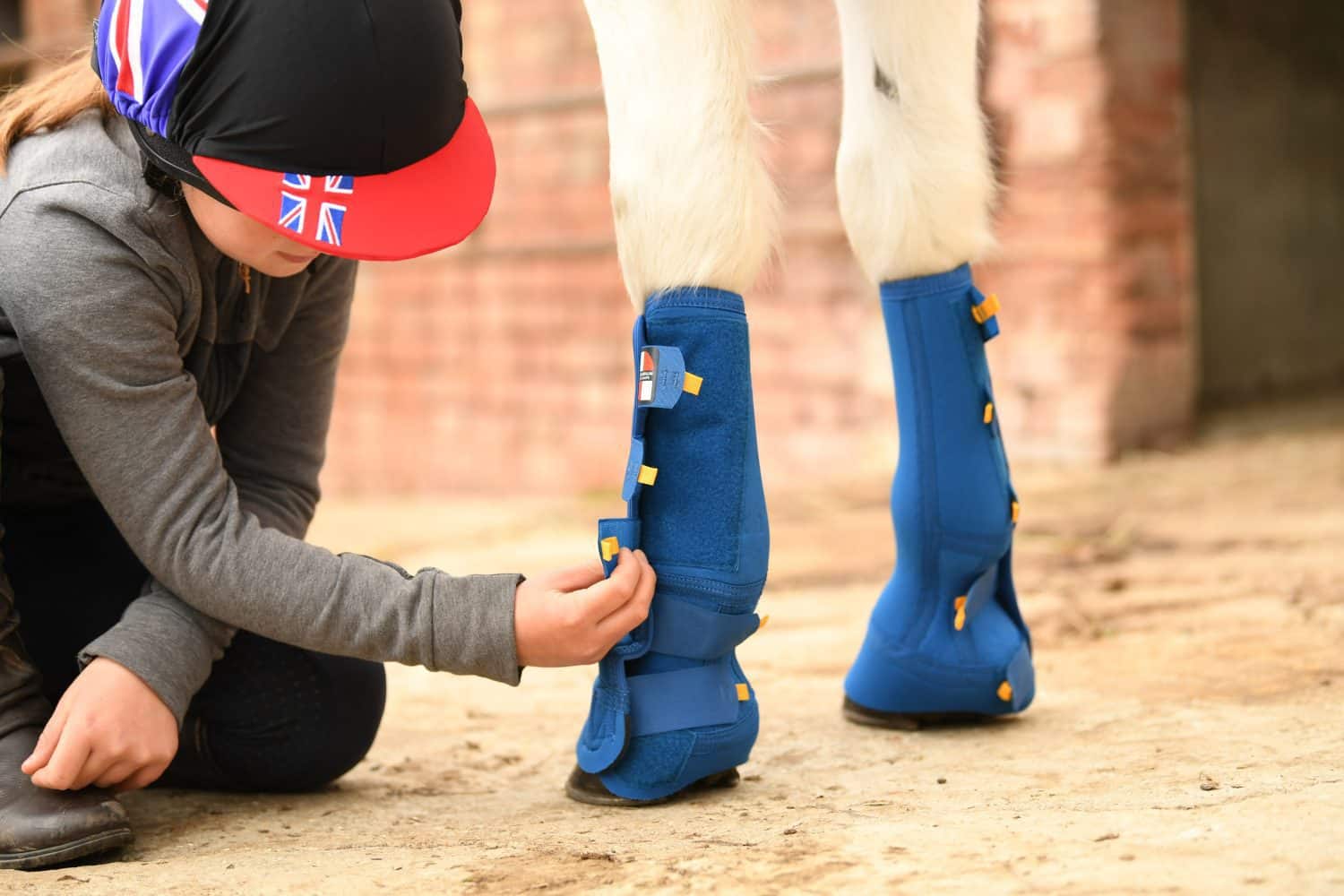
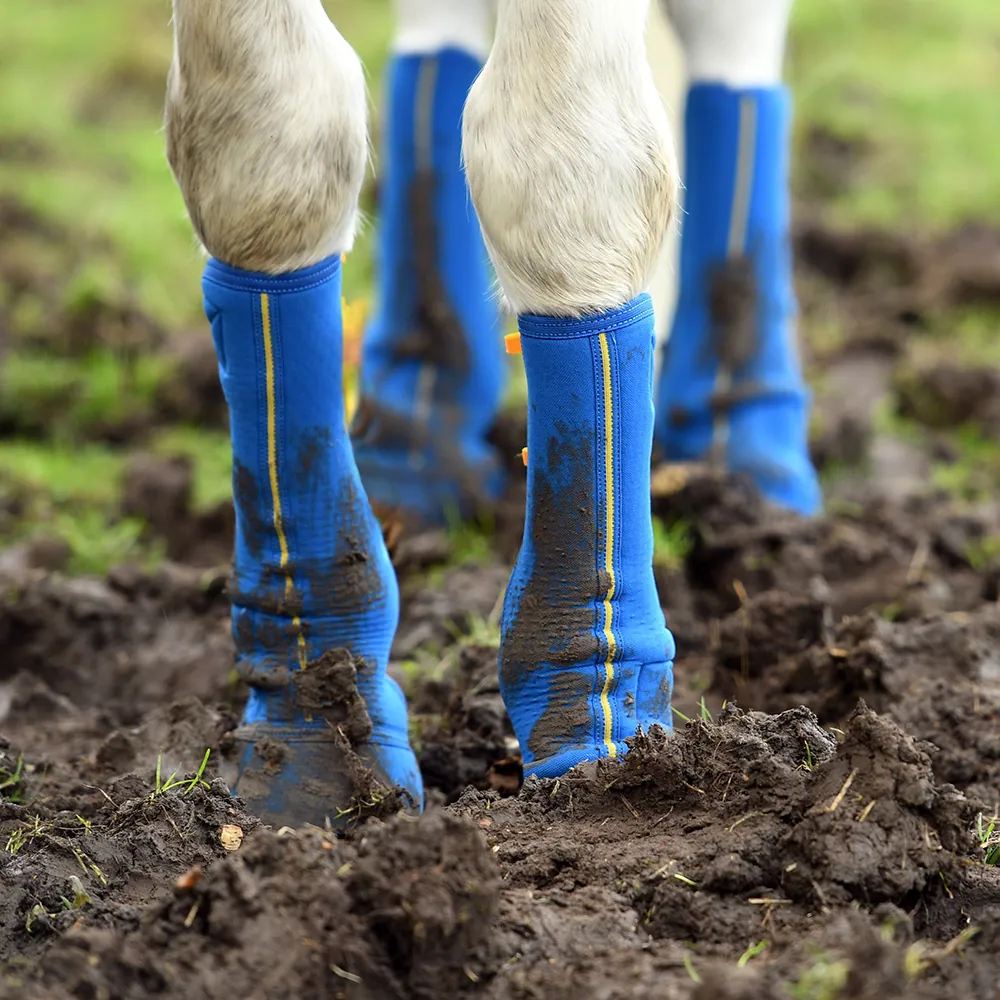
The Equi-Chaps from Equilibrium look like shipping boots on first glance, but they’re actually intended for protection from mud fever and keeping a horse’s leg dry from knee to hoof. They’re made from perforated neoprene that stretches in all four directions to allow proper fit without restriction of movement. The boots stretch down to the top of the coronet band to prevent mud and water from getting underneath and causing mud fever.
The boots feature multiple Velcro tab closures with pull tabs to make it easier to close the boot and keep it from sliding down. They’re made using heavy-duty construction techniques to help them hold up to the strain a horse can put on a set of boots in pasture.
One set can fit front and rear legs. Clean the boots in the washing machine at low temperature and hang them to dry.
Buy at EquilibriumProducts.com | Buy on Amazon
Woof Wear Mud Fever Turnout Boots (Best for Mud Fever Protection)
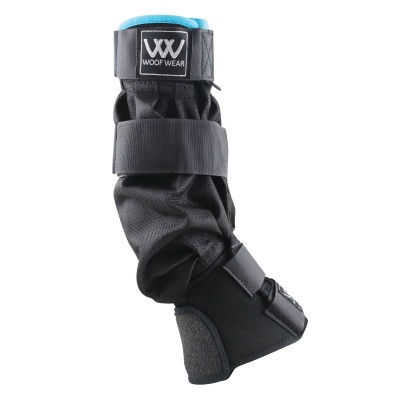
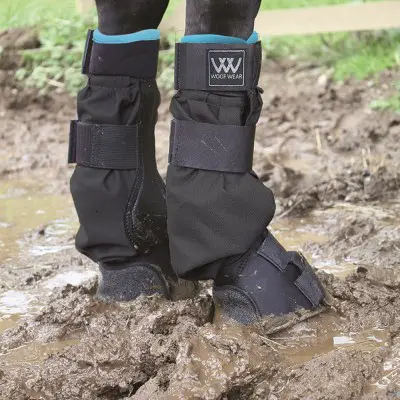
Toklat’s Woof Wear mud fever turnout boots deliver complete protection for horses who are prone to mud fever scratches on the pastern and fetlocks. The upper portion of the boot features a loose-fitting cover that’s cinched around the horse’s leg with Velcro straps and a close-fitting boot that covers the hoof. A Velcro closure on the hoof boot helps keep everything in place.
Owners of horses who are prone to mud fever will appreciate what these boots have to offer. Mud fever is painful and can take a long time to resolve. Preventing its occurrence in the first place is key to keeping a horse comfortable. These mud fever boots simplify turnout in muddy pastures and wet weather conditions and reduce the likelihood of the contraction of mud fever.
The boots use a breathable material to keep the legs dry and clean in all weather. There’s a strike plate on the inside for protection. The bell boot section is designed to prevent mud from coming up into the boot, and the heel is coated in Kevlar for strength. The boots are machine washable at a cool temperature and on a gentle cycle. Hang dry (but not in strong light).
Buy on HorseLoverz.com | Buy on Amazon
Shires Mud Socks Horse and Pony Turnout Boots (Best for Winter)
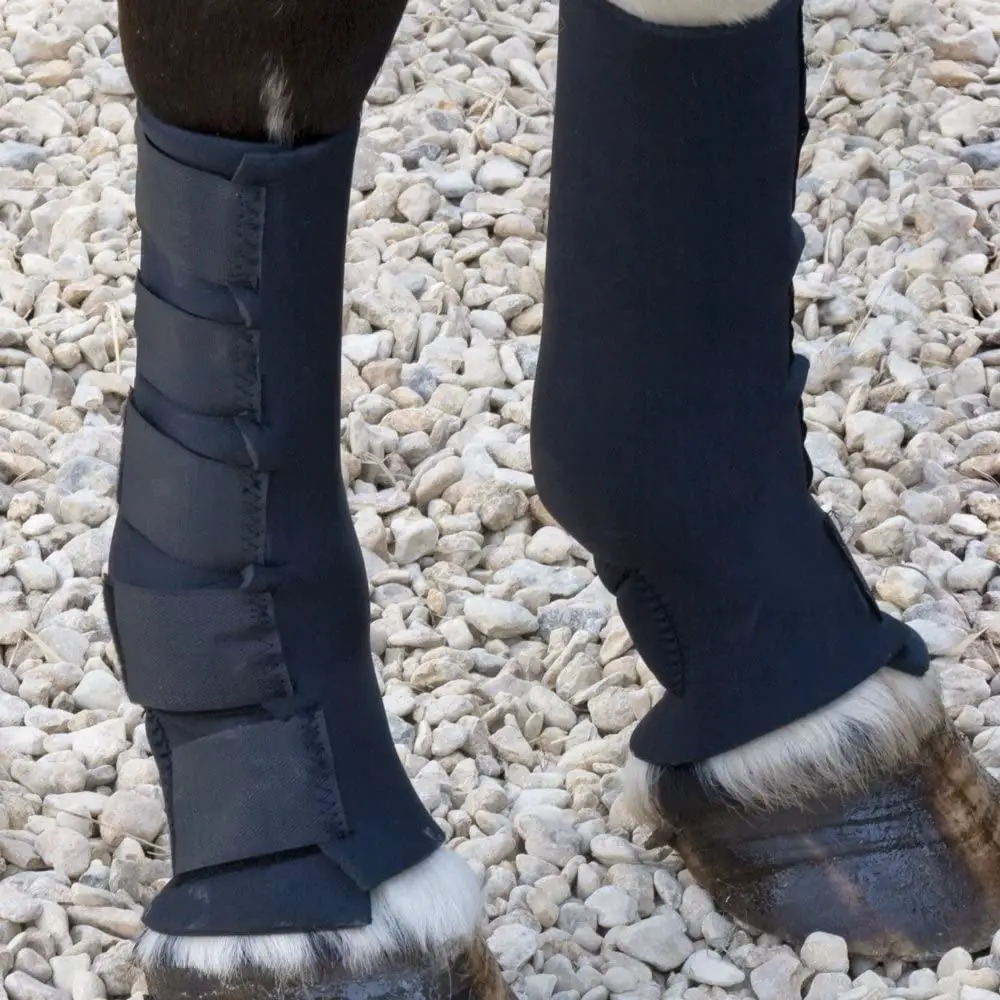
Shires Mud Socks feature a shipping boot design that covers the leg from just below the hock and knee to past the coronet band. The boots are made entirely from neoprene for breathability, flexibility, and ease of fit.
Velcro tabs from the top to the bottom of the boot make it easy to close the boot to the horse’s leg and keep out mud. Their design also minimizes slippage as the horse moves.
The boots are intended for use during winter as the full coverage design means heat doesn’t escape easily. Clean with a hose, use a brush to remove dirt, or wash in the machine on a cool setting and hang to dry.
Cashel Stall Sore Boot (Best for Healing Sores)
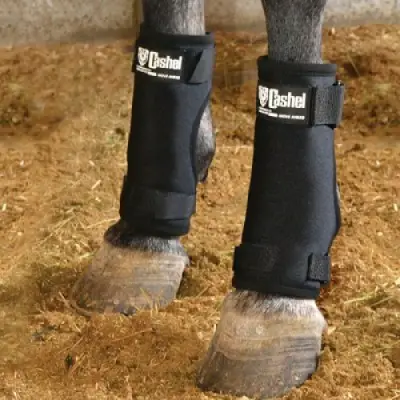
The Cashel stall sore boot is designed to help heal the sores a horse receives when lying down in the stall. But these can also be used during turnout due to their construction and closure design.
The boots address the fact that horses lie down anywhere they feel comfortable, only to give themselves sores when they stand up. When a horse wears the boots, they can’t easily grab their front legs with their hind feet, preventing further sores.
The boots are made from neoprene, feature a cut-out in the rear fetlock area, and connect behind the pastern for protection of the joints. A soft fleece lining helps with impact protection and makes the boots comfortable to wear. Turn-back buckles with Velcro straps make it easy to close the boot snugly around the leg.
They’re machine washable in cold water and should be hung to dry.
Buy on HorseLoverz.com | Buy on Amazon
Rhinegold Breathable Neoprene Turnout Boots (Most Affordable)
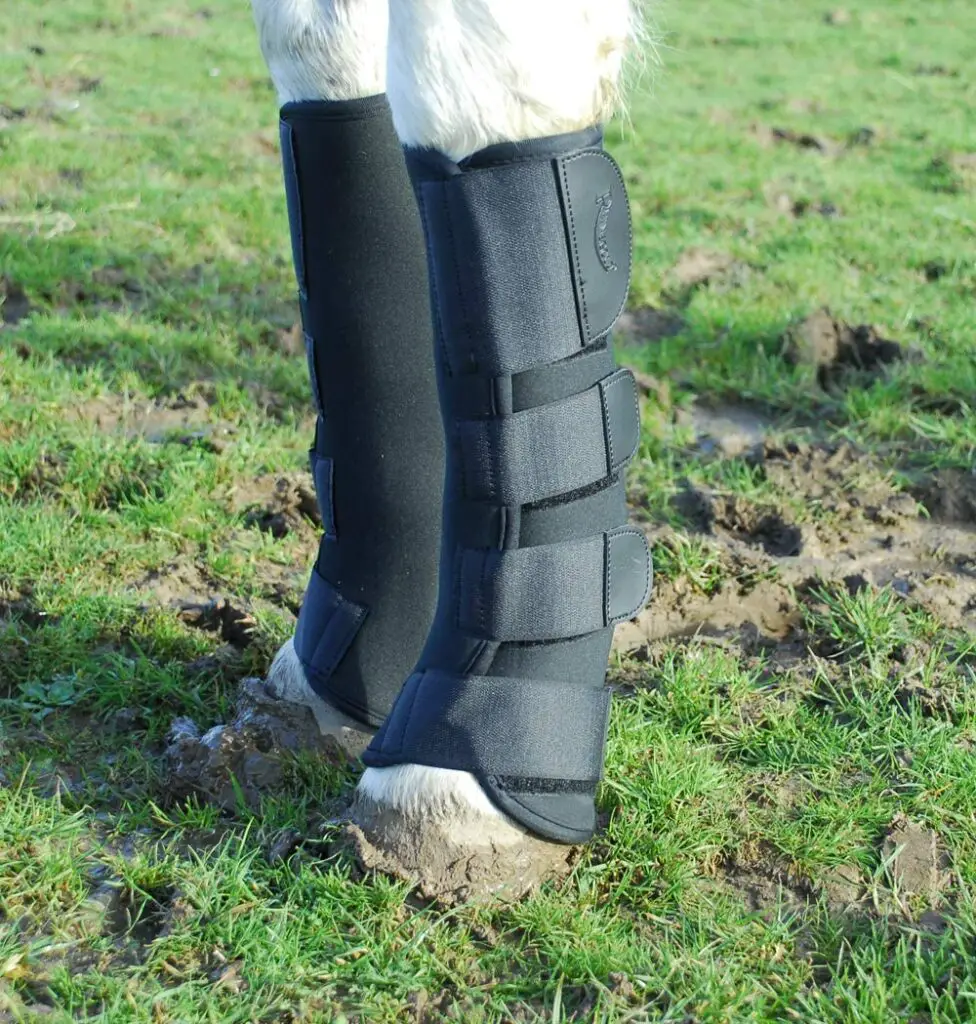
Rhinegold’s breathable neoprene turnout boots feature full coverage from knee to below the coronet band. They’re designed to prevent mud fever when conditions are wet and muddy by keeping mud out. The boots are made from ventilated neoprene and feature a center front closure.
Velcro straps of varying widths help to secure the boot in place and deliver an adjustable fit. The neoprene fabric conforms to the horse’s leg without restrictions as well as conforming to the horse’s legs.
A single pair can fit front and rear legs, and a cutback shape at the top and bottom allow for movement. Machine washable on a cool setting, or clean with a hose and soap.
Harrison Howard Horse Fly Boots (Best for a Set of 4)
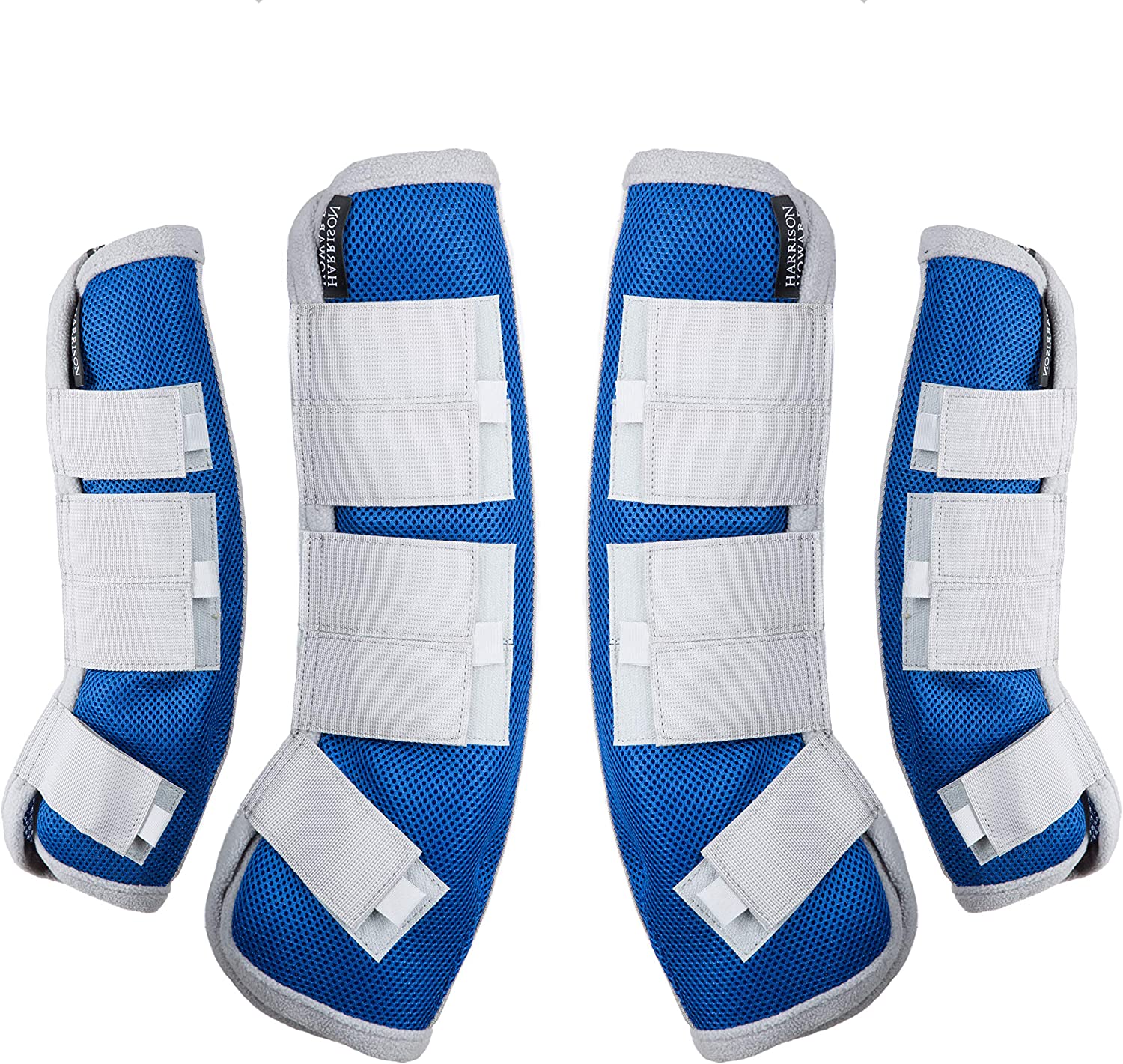
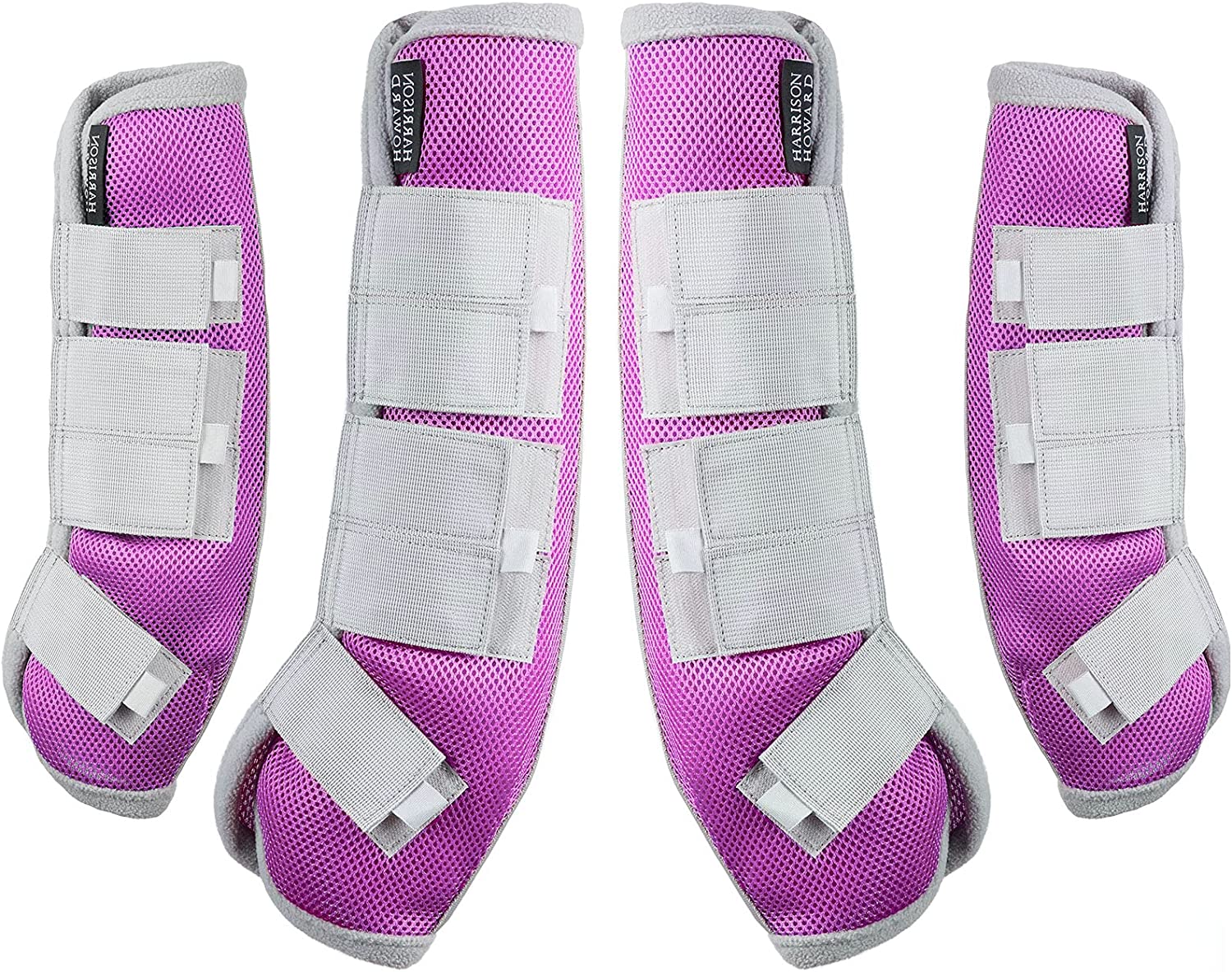
This is a full set of boots that feature an ergonomic design and are made from durable mesh material. The material is designed to prevent flies from landing, which reduces leg stomping. The curved shape and protection against flies means the boots stay in place and aren’t prone to slippage. A fleece edging goes all around the boots, creating a seal that prevents flies from getting into the boots.
Wide Velcro straps on the body of the boot make the boots adjustable and can be pulled snug against the legs. The boots come in different colors to add some fun and variety to your horse’s turnout time. They’re not machine washable, but they can be cleaned with a hose and hung dry to preserve their shape.
Shires Equestrian Horse Airflow Turnout Socks (Best Soft & Lightweight Option)

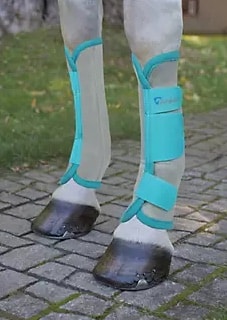
Shires airflow turnout socks are stylish mesh boots that prevents biting bugs from landing while making your horse look great during their turnout time. They’re made from UV-resistant Air Motion 3D fabric mesh that lets air flow through and reduces heat build up.
They’re easily applied to the leg and use Velcro closures to keep them on the leg. The fronts and rears are long enough to reach to just under the knee and hock, and are contoured in front to allow for movement.
The socks feature a stiffened vertical seam in the back of the boot to keep them from sagging. The edges are bound with fleece to prevent rubbing as the horse moves. Shires makes the socks in a variety of patterns, but you may want to get the zebra stripe for maximum protection against flies. A study showed a zebra’s stripes keep flies away, and a pattern works as well as a striped hair coat. Clean with a brush, vacuum, or damp cloth.
Buy from Stateline Tack | Buy on Amazon
There’s a boot for every turnout need, and you’ll probably find that you’ll wind up owning a variety of types for a multitude of uses.
Keep in mind that turnout boots are designed to be tough and put up with a lot of wear and tear from your horse, but be prepared for damage over time and a loss of effectiveness. The ultimate goal of using a turnout boot is to protect your horse’s legs from damage, and the turnout boots listed here help you do just that—along with keeping your horse comfortable!
If you’re also in need of some leg wraps for your horse, check out this article.
Like this post? Save it on Pinterest. Follow me on Pinterest.


